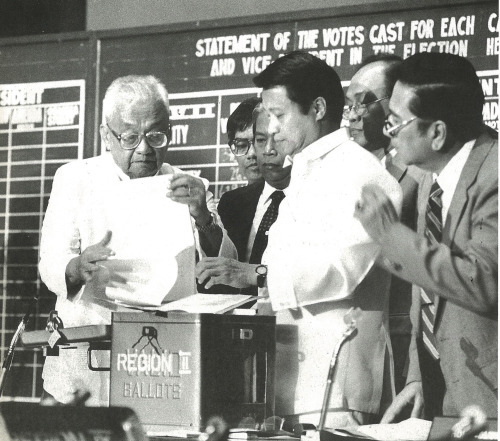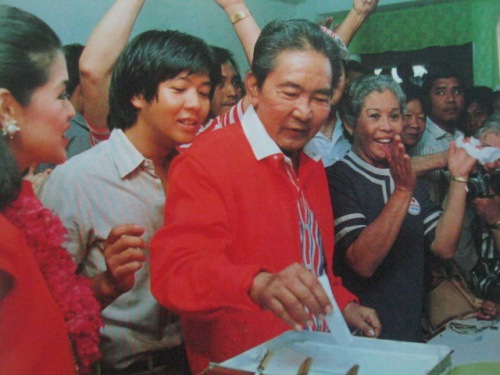Marcos pa rin? The winner of the 1986 Philippine elections
How Marcos could have won
The main thrust of this argument is that while the official COMELEC (Commission on Elections) count was allegedly tampered to give Marcos an overwhelming victory, the completed NAMFREL count would have still given Marcos the election. Supposedly. Of course, the margin was closer than that of the official count. The NAMFREL (National Citizens' Movement for Free Elections) was established in 1983 to ensure that the right vote was cast. This was done by doing its own unofficial count to verify the official results.
 |
| The Batasang Pambansa proclaimed Marcos as the victor. Photo courtesy of the Presidential Museum and Library. |
For president
| Ferdinand Marcos | 10,807,197 |
| Corazon Aquino | 9,291,716 |
| Reuben Canoy | 34,041 |
| Narciso Padilla | 23,652 |
| Arturo Tolentino | 10,134,130 |
| Salvador Laurel | 9,173,105 |
| Eva Estrada Kalaw | 662,185 |
| Roger Arienda | 35,794 |
Evidently, Marcos was ahead by more than 1.3 million votes (a difference of 7.3 percentage points), while Tolentino's margin was a shy of one million votes (4.8 percentage points).
Meanwhile, the partial NAMFREL count (accounting to 69% of all precincts) have shown Aquino and her running mate, Salvador Laurel, in the lead. The former was ahead by more than 715,000 votes (5%) and the latter by 870,000 votes (6.1%). Had the NAMFREL count been completed, would Marcos have won in the unofficial count as well? There are claims that NAMFREL did complete the count a year later, in 1987, but there is no documentary evidence that it did so. Not even in the NAMFREL archives. Nevertheless, whether this evidence was not accessible by accident or purposely, there is another way to complete the NAMFREL count. The partial unofficial count recorded how much of the ballots are not yet counted. Regions wherein the count was almost complete at this point were Metro Manila (NCR, 92%), Bicol (Region V, 79%), and Eastern Visayas (Region VIII, 79%). The lowest among the regions in terms of tally completion were Cagayan (Region II, 29%) and Central Mindanao (Region XII, 39%). While not a foolproof technique, simulating the tallies to 100% using the partial count's statistical trends might make it possible to compare with the official results.
The partial NAMFREL results are as follows:
For president
| Aquino | 7,502,601 |
| Marcos | 6,787,556 |
For vice president
| Laurel | 7,255,955 |
| Tolentino | 6,385,293 |
| Kalaw | 591,589 |
In his biography, the Voice of Dissent, vice presidential candidate Arturo Tolentino notes how the KBL machinery helped Marcos more than him. The total votes cast for the presidential and vice presidential elections were 151,000 votes apart. This is where Tolentino points the opportunity to add votes for Marcos (what Tolentino called "padded votes"). In fact, the official results show Marcos having 673,000 votes more than his running mate. If Kalaw's votes are subtracted, Marcos would still have around 11,000 votes more than Tolentino.
Of course, if the padded votes were subtracted, it would mean that Marcos would still be the clear winner with 700,000 votes. How about the simulated unofficial count?
The simulated results are as follows:
The simulated results are as follows:
For president
| Aquino | 10,668,594 |
| Marcos | 9,884,653 |
For vice president
| Laurel | 10,380,382 |
| Tolentino | 9,370,798 |
| Kalaw | 802,843 |
 |
| Marcos casts his vote in Ilocos Norte. Photo courtesy of Bayan Ko. |
How does the completed NAMFREL results compare with the COMELEC results? Apparently, the delayed votes did not help Marcos win. From 47.5% in the partial count, Marcos polled only 48.1% if the NAMFREL tally was finished. Indeed, it was distant from the official count, which gave Marcos 53.6% of the vote. Meanwhile, Tolentino was up to 45.6% in the completed count from 44.9% in the partial count. It is also apparent that the delayed votes did not help Tolentino achieve victory.
In contrast to the official count, which showed a difference of more than 151,000 votes between the presidential and vice presidential tallies (the "padded" votes), the simulated results show a difference of only 886 votes. Evidently, the so-called "padded" votes virtually disappear if the NAMFREL count is completed. Indeed, 151,000 votes is still statistically significant to influence any election, especially in a close one (0.7% to 0.8% of the total vote). Actually, this simulated count shows a closer election than both the official COMELEC count and the partial unofficial NAMFREL count. Meanwhile, third party candidate for vice president, Eva Estrada Kalaw, performed fairly better in this simulated tally compared to the COMELEC data. In the official count, she garnered only 3.3% of the vote. In the completed unofficial count, she had 3.9%, a difference of around 121,700 votes. In a two-way race between Tolentino and Laurel, the former would have 47.5% and the latter 52.5%. Kalaw gained 1.9% from Tolentino voters and 2% from Laurel voters. Thus, her support took away votes from both major candidates, albeit she took slightly more votes from the vice presidential candidate of UNIDO.
How accurate is this model?
First used in the 2016 Philippine elections, the model used in this article projected through a modified polls-only approach that the presidential election would finish with a solid Duterte victory, albeit only a plurality. In particular, Rodrigo Duterte is predicted to gain 39% of the vote, Manuel "Mar" Roxas to gain 24%, Grace Poe 21%, Jejomar "Jojo" Binay 12%, and Miriam Defensor Santiago 4%. The actual result revealed the accuracy of this model. Duterte had 39% of the vote, Roxas 23.5%, Poe 21.4%, Binay 12.7%, and Santiago 3.4% in the final tally. There is an average discrepancy between the model's predictions and the actual results of only 0.4%.
From national to local
This time, the discussion turns to the local arena. How did the thirteen regions of the nation vote in 1986? According to the COMELEC count, Aquino won in Metro Manila (54%), Region IV (55%), Region V (65%), Region X (51%), and Region XI (52%). Marcos won in the remaining eight regions. In the completed NAMFREL count, Aquino won in Metro Manila (54%), Region III (56%), Region IV (57%), Region V (64%), Region VII (60%), Region IX (52%), Region X (51%), Region XI (54%), and Region XII (56%). From eight regions, Marcos gained victory only in four regions in this count. Apparently, this is enough to give Aquino the election. Aquino achieved a close victory, but not close enough to be contested. The closest national election in Philippine electoral history is the vice presidential election in 1965. Marcos's running mate, Fernando Lopez, defeated Gerardo Roxas with 26,724 votes (0.37%). Then again, Lopez still served as vice president, with Roxas gracefully accepting defeat.
Speaking of the vice presidential election, Laurel won in the following regions (according to COMELEC): Region IV (68%), Region V (68%), and Region XI (51%). Tolentino was leading in the remaining ten regions. However, in the completed NAMFREL count, Laurel won in Region III (50%), Region IV (69%), Region V (65%), Region VI (49%), Region VII (55%), Region IX (51%), Region X (51%), Region XI (50%), and Region XII (53%). Tolentino won in only four regions. Meanwhile, Kalaw was strongest in Metro Manila (8.1%), Region I (7.8%), and Region III (6.1%).
What may be noted from the two tallies are the following:
- Metro Manila went for Aquino (54%) and Tolentino (47%). Evidently, Tolentino hailed from Metro Manila. Nevertheless, his home region did not go for his running mate, Marcos. This is also an unlikely result from a region that always voted for the opposition. In a way, there might be more than regionalism behind Tolentino's performance. Still, it may also mean a recognition of Tolentino as an opposition man, a stand that he maintained in his biography. Another possible cause is the strong showing of Kalaw in Metro Manila, which may have divided the opposition.
- Region III (Central Luzon) went for Aquino (56%) and Laurel (50%). With their vote shares almost identical, Aquino probably lifted her running mate in her home region. However, while Region IV (Southern Tagalog) also went for Aquino (57%) and Laurel (69%), their vote shares were distant enough to assume that Laurel did not carry his running mate in his home region.
- Region V (Bicol) also went for Aquino (64%) and Laurel (65%). The scenario is seemingly similar to their vote share in Region III.
- Solid North (Regions I and II) remained solid for Marcos and Tolentino. The machinery of the incumbent Marcos probably carried his running mate in his home region after all. Tolentino had 64% of the vote in Region I, and 62% in Region II.
- However, Marcos's lead in Regions I (Ilocos, 68%) and II (Cagayan, 59%) was not enough to gain lost ground to Aquino in other parts of the country.
- Marcos and Tolentino did not win any region in Mindanao. However, the tandem won in the home region of Imelda Marcos, Region VIII (Eastern Visayas).
- Kalaw received the greatest support not from her home region (Region III), but from Metro Manila. Nevertheless, the opposition-supporting region went for Tolentino.
As far as this article is concerned, Marcos did not achieve electoral victory in either the partial or the complete NAMFREL count. Whether or not Marcos won in 1986, he achieved yet another victory in 2016. On November 18 of this year, he was finally buried in Heroes Cemetery (Libingan ng mga Bayani) based on his merits as a former soldier, defense minister, and president. Of course, the issue of his heroism (and in the first place, the concept of being a hero) cannot be tackled in this article. In fact, it might take more than one or two articles to discuss it.
See the references for more details.
"I want to be remembered as having saved this country from anarchy and from being overtaken by strange ideologies and overcame by vicious violence. I would like to be remembered less as a soldier and more as a thinker. I intend to retire to writing, finish that history book of the Philippines that I started when I was still a new graduate, and write a few more books."
(Ferdinand Marcos, Sr., 1981)





Comments
Post a Comment